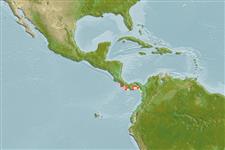>
Ophidiiformes (Cusk eels) >
Ophidiidae (Cusk-eels) > Ophidiinae
Etymology: Lepophidium: Latin, lepus, leporis = rabbit + Greek, ophis = serpent (Ref. 45335).
Environment: milieu / climate zone / depth range / distribution range
Ecología
marino demersal; rango de profundidad 73 - 209 m (Ref. 91765). Tropical; 10°N - 4°N, 84°W - 77°W (Ref. 91765)
Distribución
Países | Áreas FAO | Ecosistemas | Ocurrencias, apariciones | Point map | Introducciones | Faunafri
Pacific Coast of northern Colombia to Costa Rica.
Tamaño / Peso / Age
Maturity: Lm ? range ? - ? cm
Max length : 21.7 cm SL macho / no sexado; (Ref. 91765)
Short description
Morfología | Morfometría
Radios blandos dorsales (total): 128-134; Radios blandos anales: 108 - 113; Vértebra: 71 - 73. This species have the following characteristics: pyloric caeca usually 4-8 in 2 whorls, typically 2-3 in first 2 whorls and 1in third; usually 3 rudimentary gill rakers on the upper arm of the first arch and 5-7 developed rakers on lower arm, 1-6 rudimentary rakers anteriorly on the lower arm; total gill rakers 9-14; dorsal-fin origin between neural spines 3-4; roof of mouth posterior to the palatine and vomerine tooth patches blackish, also the gill bars, upper pharyngeal region, esophagus, caeca, and anterior part of the intestine; pectoral fins dusky; dorsal and anal fins have a dark edge; males have the anterior rib thickened (Ref. 91765).
Life cycle and mating behavior
Madurez | Reproducción | Puesta | Huevos | Fecundidad | Larva
Robins, C.R., R.H. Robins and M.E. Brown, 2012. A revision of Lepophidium (Teleoastei, Ophidiidae), with descriptions of eight new species. Bulletin of the Florida Museum of Natural History 52(1):1-94. (Ref. 91765)
IUCN Red List Status (Ref. 130435)
Threat to humans
Harmless
Human uses
Más información
PaísesÁreas FAOEcosistemasOcurrencias, aparicionesIntroduccionesStocksEcologíaDietacomponentes alimenticiosconsumo de alimentoRación
Nombres comunesSinónimosMetabolismoDespredadoresEcotoxicologíaReproducciónMadurezPuestaAgregación para la puestaFecundidadHuevosEgg development
Age/SizeCrecimientoLength-weightLength-lengthLength-frequenciesMorfometríaMorfologíaLarvaDinámica larvariaReclutamientoAbundanciaBRUVS
ReferenciasAcuiculturaPerfil de acuiculturaRazasGenéticaElectrophoresesheritabilidadEnfermedadesProcesamientoNutrientsMass conversion
ColaboradoresImágenesStamps, Coins Misc.SonidosCiguateraVelocidadTipo de nataciónSuperficie branquialOtolitosCerebrosVisión
Herramientas
Special reports
Download XML
Fuentes de Internet
Estimates based on models
Phylogenetic diversity index (Ref.
82804): PD
50 = 0.5000 [Uniqueness, from 0.5 = low to 2.0 = high].
Bayesian length-weight: a=0.00102 (0.00046 - 0.00225), b=3.06 (2.88 - 3.24), in cm total length, based on all LWR estimates for this body shape (Ref.
93245).
Nivel trófico (Ref.
69278): 3.6 ±0.7 se; based on size and trophs of closest relatives
Resiliencia (Ref.
120179): Alto, población duplicada en un tiempo mínimo inferior a 15 meses (Preliminary K or Fecundity.).
Fishing Vulnerability (Ref.
59153): Low vulnerability (16 of 100).
